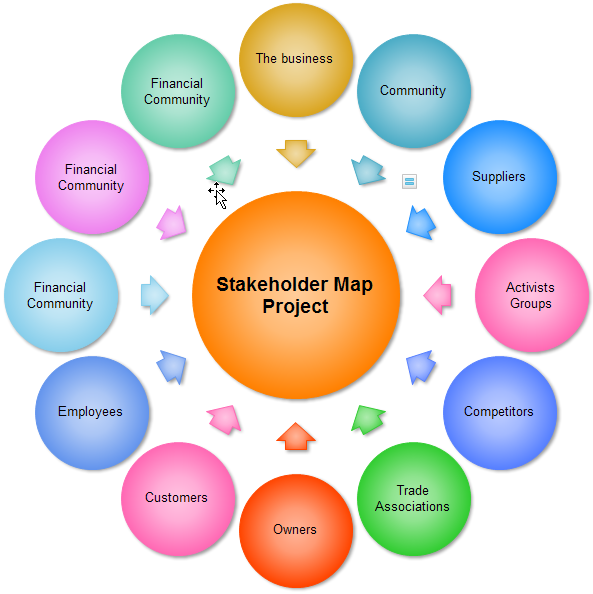Basic Steps of Creating Stakeholder Map
Basic Introduction:
Stakeholder mapping might not as well-known as stakeholder analysis. Stakeholder Analysis (SA) is a technology for investigating the internal and external environment of an organization, while stakeholder map is the visualized presentation for stakeholder analysis. A lot of information can be added to the stakeholder map, such as the stakeholder's standpoint, relevance to the organization, and the attitude toward us, etc. They can be identified as active, neutral, and passive according to their attitudes and standpoints.

Steps:
1. Identify the organization's various external and internal stakeholders, which could be done by brainstorming. When you begin mapping the stakeholder flowchart, put your organization in the center, and all the stakeholders around your organization. It's better to put them into logical order if possible. For example: put the suppliers on the left side and customers on the right side. Put employer of authorities on top, and make inside stakeholders stay together. Besides, use arrows to connect the stakeholders to your organization.
2. Analyze the stakeholders' requirements and expectations. You can brainstorm again. Or in some circumstances you can also ask the stakeholders directly to have a direct answer. After you get the requirements and expectations, abstract the important points and put them on top of the arrows.
3. Assess what position of your organization the stakeholder has placed.
Mark the stakeholders with different colors according to their standpoints. For example, green represents active, yellow represents neutral, red represents passive.
Practical tips:
a. There are two common mistakes while making stakeholder flowchart. One is that the listed stakeholders are too few, which may cause the overlook of the stakeholders that may have true impact on the organization in the future. The other mistake is that the listed stakeholders are more than enough, which may cause the flowchart overcomplicated, and cover the real important information.
b. If the stakeholders you list are not enough, try to add more people into discussion and offer advice. Categorize the possible organizations systematically and check one by one. Such as public institutions, financial institution, customer, suppliers, research partners, educational institution, non-profit organization, etc.
c. If there are too many stakeholders, check again and pick out the ones less relevant.
d. Never be afraid to ask if you are not sure about the stakeholder's standpoint and future expectation. If your stakeholder map is based on a null hypothesis, there will be potential trouble in your future plan or decision. Don't be shy, most stakeholders are ready to answer your questions.


